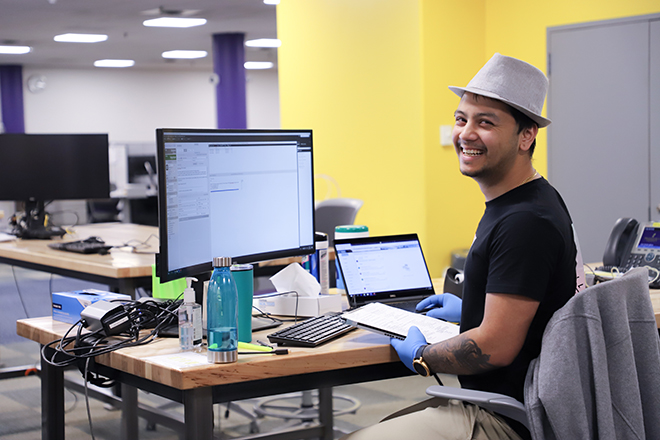Before the University went into pandemic mode, its Zoom online-meeting platform was used about 20 times a day on campus. By April, it was averaging 800 meetings a day, with one of those days tallying 300,000 meeting minutes.
Handling Zoom was just one of the demand issues that kept the University’s 50-plus member Information Technology Solutions staff and 100 students busy as University life went from buildings and classrooms to kitchen tables and laptops.
“We had to put up a whole bunch of technology that allowed people to use what they did at their home desk, their home office or their home kitchen,” said Mark Johnson, vice president and chief information officer of IT Solutions. “They had to really pivot to that. So the team really pulled together and implemented a whole bunch of really unique technology that allowed people to work from home.”
While students and staff were on the extended spring break, during which time they were told classes would resume online, the IT teams had their work cut out for them.
“We had to figure out how to get all that information pulled together, organized, delivered and accessible to people,” Johnson said.

Part of that involved enhancing the existing virtual private network (VPN,) which allows a user to access university networks while away from the university. The IT team not only expanded the VPN, it created a similar, better system that allowed hundreds of users. Usage went from 50 people at the start of work-at-home to upwards of 500 by late April.
While programs such as Zoom get plenty of attention nationwide during the pandemic, the trick was to transform everyday work tasks for faculty and non-instructors online, he added.
“Some people had to do things like accounts payable, accounts receivable and they could only do it inside the university so we protect the information,” Johnson said. “We had to help them be able to do it outside the university but still protect the information. Some people had to make hundreds and hundreds of phone calls to students which we’ve never done before. But they had to make it so that they did not have to use their own cell phone – we gave them technology they could use on their computer to make phone calls from the campus, from their homes.”
One reason IT was able to function well for the entire campus was that staff are not only assigned as IT contacts to various colleges and programs, they’re embedded I n those programs.
“We call them solutions architects,” he said, “people with day-to-day responsibilities inside each organization. … That is a perfect fit for when this started to happen. I had people deployed all through the organizations, [saying] here’s what we’re doing or here’s where we need help.”
When it became clear in conversations with student government that not all students were tech-heavy, that some in fact didn’t have laptops, IT purchased hundreds that students could use. The library staff arranged a safe, drive-up pick-up site.
IT also installed free wi-fi on campus parking lots. “Just all kinds of things to keep learning that we had to look at and figure out,” Johnson said.
At the same time, the mission of IT went beyond the technical, hence the creation of a key component of the University’s COVID web page: Links titled “Keep Teaching, Keep Working and Keep Learning.” These linked users to guides for best practices and practical help in the often unfamiliar territory.
“If you’re running a class and you’re trying to get 60 people to participate, you’re going to need a lot of help – how to get hands raised, etc.” Johnson said. “So we developed a whole portfolio.”
The extra equipment, the expanded access and the lessons learned in the pandemic response will all be put to use in the campus of the near-future, Johnson said. Especially during what will surely be challenging times ahead.
“We’re integrating all these lessons, equipment and insights into how we advance the institution,” he said. “We as IT leaders can also be leaders of the institution. Not in the sense of taking things over, but in creating an environment in which we can pivot and change like we’re going to have to.”
Speak Your Mind